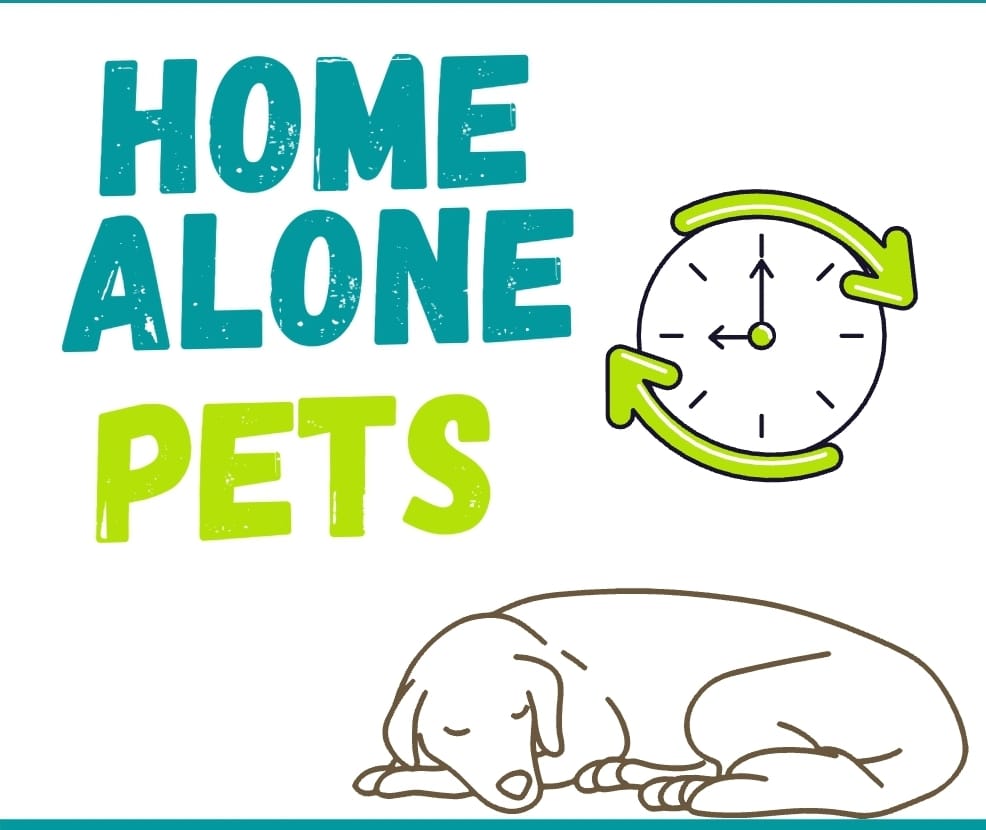
ANIMALS 101 – ARE YOUR PETS FINE AT HOME ALONE?
Although through COVID-19, many pets have had their owners around more often, we understand that you can’t be with your pet all the time. How long they are left alone, however, includes various factors.
Sadly, we can share many horrible stories on what happened to pets while owners were away or how many people will go away for days with no one checking in on them. This is highly irresponsible! They are your responsibility, and you chose to be their guardian.
When we drive around, we often sadly see animals in “empty” yards, with basically nothing to help them cope for 8-10 hours when you are at work. Safety is important when you leave toys out, but they need stimulation, shelter, food, and water! You won’t leave a kid alone, never mind without any of the above, right?
Our biggest concerns when animals are left alone include pet theft, poisoning, and health-related emergencies. Some animals get very depressed and can even stop eating or drinking when their owner is out. Separation anxiety is another issue.

The Animal Humane Society explains:
Dog-parent guilt is a real thing, no matter how much time you spend with your pooch. We’re the centre of their universe, which is part of the reason we love them so much!
Even if we want to, we can’t take them everywhere we go. So, how long should your dog be left alone?
Answer: It depends.
It’s not a yes or no question. How long your dog can stay home alone depends on your dog, their age, as well as their physical and emotional needs.
Before leaving your dog alone for more than a few hours at a time, consider the following:
Your dog’s bladder control – if left inside.
How often your dog needs a break outside depends on their bladder control. Like humans, age, hydration, and their physical build affect how often your dog needs to relieve themselves. Young puppies and elderly dogs will likely need more frequent breaks outside.
“There’s no one-size-fits-all time frame, but 10 to 12 hours is considered too long to leave a dog alone; they also shouldn’t go without a potty break every four to six hours”, says Dr. Karen Becker, a Canadian Veterinarian.
Your dog’s physical needs and what they’re used to will determine how long they can stay home alone. Set a routine for your furry best friend that works for you both. Try letting your dog out the last thing before you leave for the day and first thing when you get home.
Your dog’s emotional needs.
Is your dog active, or are they couch potatoes? Can they play fetch for hours on end, or do they prefer cuddling on your lap? Do they need social interaction, or do they prefer to spend time on their own?
How long your dog can stay home alone also depends on what daily exercise and interaction they need from you. Maybe they like the long hours to curl up on your bed while you’re out of the house. Or maybe they need daily two-mile walks and safe toys to play with.
Changes in behaviour.
If you notice a behaviour change in your pet due to being alone too long, it could be a sign to take some action. Examples of behaviour changes include increased lethargy, depression, or disinterest in once-beloved activities and destructive tendencies. With any behaviour changes, see your veterinarian to rule out medical issues.
Destructive behaviour is also a symptom of separation anxiety. Dogs are social and typically prefer to be with others. Some may always struggle with being alone. When a dog doesn’t know how to self-soothe or cope, they may turn to chewing or clawing stuff around the house or barking or howling.

FACTORS TO CONSIDER WHEN YOU GO OUT (short or long)
- Is your yard/house is safe and secure?
- Do they have enough food? Including if your away time is extended unexpectedly.
- Do they have lots of fresh water?
- Do they have shelter from the elements like sun, wind, rain, etc.?
- Is there someone who can check in on them?
- Is your pet sitter listed at your veterinarian in case of an emergency?
- Are their medication and medical records together?
- Do they have a microchip that is registered with up-to-date details or at least an ID collar with your number?
- What is the plan if something does happen to you?
- Do you have notices on the window of how many pets there are to rescue in case of a fire, or have an escape route?
- Do you have an emergency card about your pets in your wallet or car in case of an accident? (which includes an emergency contact, not the address)
- Have you considered cameras to check in with?
- What have you done to prepare your storm-phobic pet for changing weather conditions?
- Are your pets and instructions about them included in your will?
WAYS TO IMPROVE THEIR ALONE TIME
Managing how your dog spends their time alone can help your pup feel more satisfied or fulfilled while you’re away. It also provides you with some peace of mind. Some options include:
- Hire a dog walker, even a day or two per week.
- Get a pet sitter to check in.
- Doggy day care, even once a week, can make a difference.
- Provide mentally stimulating toys such as treat puzzles.
- Leave the TV or radio on (we are hesitant about this with electrical risks).
- Get another pet (only works if they get along). Social animals should not be alone.
Here is another site to visit and read about Home Alone Pets
Finally, remember that when you bring home a new dog or any pet, you’re committing to a long-term relationship. Be sure you have time to dedicate to your new family member. Working full-time or having a busy life and owning a pet is possible; you may just have to get creative to ensure their needs are being met. Find an animal that fits your lifestyle.
Are your pets taken care of when you are not home? Do you have an emergency or backup plan? Remember, they are your responsibility!
Thanks for tuning in! Next week, we will look at what kind of bones your dogs can have.
WHEN YOU KNOW BETTER, DO BETTER!